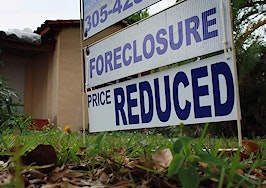Rising home prices means Americans hold an all-time high $9.1 trillion in tappable home equity, which they’re starting to cash out at levels not seen since since the 2007 housing bubble.
But as long as prices don’t crash, the rise in home equity — the value of a homeowner’s stake in their home, after subtracting what they owe on their mortgage — is also good news for borrowers who decided to put their mortgage payments on hold during the pandemic.
That’s according to the latest Black Knight Mortgage Monitor Report, a monthly loan-level analysis of residential mortgage data and performance metrics.
Among the 1.75 million homeowners remaining in pandemic forbearance plans as of Aug. 16, the report said, only 135,000 have less than a 10 percent equity stake in their homes — even assuming they skipped the maximum 18 months of payments.
That compares to the depths of the Great Recession of 2007-09, when 40 percent of all mortgage holders had less than 10 percent equity, and 28 percent were underwater, meaning their home was worth less than what they owned on their mortgage.
“A rising tide lifts all boats as they say, including homeowners in forbearance – whose ability to return to making payments when forbearance ends will likely be a key driver in the nation’s overall COVID-19 economic recovery,” said Black Knight Data & Analytics President Ben Graboske, in a statement.
A moratorium barring foreclosure proceedings against homeowners with federally-backed mortgages expired on July 31, but there has been no rush by lenders to repossess homes from delinquent borrowers, Black Knight found. The Consumer Financial Protection Bureau has warned lenders that it expects them to reach out to borrowers who are 120 days behind on their payments and give them a chance to apply for assistance, such as a loan modification, before foreclosing on them.
“Despite the foreclosure moratorium expiring at the end of July, daily performance data… shows very little impact on the number of loans rolling into active foreclosure, at least through the first three weeks of August,” Black Knight’s report found.
As of August 17, only 36,000 that had been in forbearance had moved to active foreclosure status, and 88 percent of those loans were already delinquent before the pandemic
“That said, given the large number of remaining pandemic-related serious delinquencies, foreclosure start volumes will be worth keeping a close eye on in coming months as loans begin to roll out of forbearance plans,” the report said.
Depending on the type of loan they have, some borrowers were eligible for up to 18 months of forbearance during the pandemic. Black Knight estimates that all told, 7.5 million borrowers were in a forbearance plan at some point during the pandemic — or 15 percent of all mortgaged homes.
While most borrowers who have been in forbearance programs have started making their payments again (48 percent) or paid off their mortgages in full (21 percent), nearly 2 million remaining borrowers are being phased out of forbearance over the next several months, starting July 31.
Homeowners exiting forbearance, by month

Source: Black Knight Mortgage Monitor.
This month alone, forbearance programs will expire for 415,000 homeowners, or about 20,000 every business day. Another 240,000 forbearance plans will expire in October, and 163,000 in November.
Before foreclosing on those homeowners, loan servicers will be required to process them through “complex post-forbearance loss mitigation waterfalls,” to determine if they qualify for a loss mitigation plan such as a loan modification or deferral of missed payments, Black Knight noted.
Loans in forbearance, by type

Source: Black Knight Mortgage Monitor.
Black Knight’s data shows that most of the 1.75 million homeowners still in forbearance in mid-August had loans that were either backed by the FHA or VA (696,000), or made by portfolio or “private label” lenders (520,000). Loans guaranteed by Fannie Mae and Freddie Mac (535,000) made up the balance.
And among the 130,000 homeowners in forbearance who had less than 10 percent equity in their homes, more than 69 percent were FHA or VA mortgages.
A new loss mitigation waterfall developed by FHA allowing eligible borrowers to reduce their monthly payments by 25 percent without providing income documentation, should “greatly improve the take-up rate and increase the number of successful modifications,” according to an analysis by the Urban Institute.
Graboske said the fact that most borrowers have strong equity positions, “should help limit the volume of distressed inflow into the real estate market as well as provide strong incentive for homeowners to return to making mortgage payments – even if needing to be reduced through modification.”
In the mean time, the massive growth in homeowner equity has spurred a resurgence in cash-out refis among borrowers who can afford to keep making their payments.
Growth in ‘tappable equity’

Source: Black Knight Mortgage Monitor.
With Black Knight data showing home prices appreciating by 20 percent in the last year, “tappable equity” — how much money a homeowner can take out of their home, while still retaining at least 20 percent ownership — hit a record $9.1 trillion. That’s up a record 37 percent from a year ago, leaving the average mortgage holder with $173,000 in tappable equity.
Mortgage refinancings, by type

Source: Black Knight Mortgage Monitor.
Homeowners have responded by pulling some of that equity out of their homes. During the second quarter, Black Knight estimates that 1.1 million homeowners took cash out when refinancing, withdrawing more than $63 billion in equity — the largest cash-out volume seen since mid-2007.
“With equity levels at record highs and interest rates broadly expected to tick upward in coming years, cash-out lending is likely to play a much larger part in the overall refinance market,” Black Knight’s report concluded.






